Copper coins of Ferdinand VII
The final series of Spanish Colonial copper coinage issued by the Mexico City mint came during the reign of Ferdinand VII. In total three types were produced for this series in the denominations of 1/16 Real (1/8 Pilon), 1/8 Real (1/4 Tlaco) and 1/4 Real (2/4 Tlaco) with various dates known for each type. These are by far the most common of any of the Spanish Colonial copper issues; however, they are extremely rare in high grade.

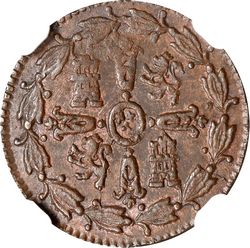
KM-59 1/16 real (⅛ vellón) 1814 Mo (Stack’s-Bowers NYINC Auction, 19 January 2023, lot 42616)
| 1814 | |
| 1815/4 | |
| 1815 |
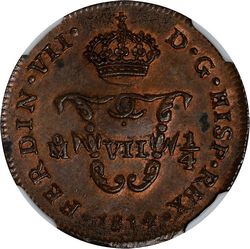
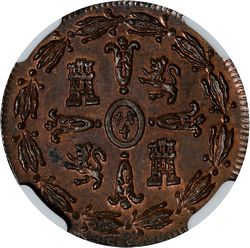
KM-63 ⅛ real (¼ vellón) 1814 Mo (Stack’s Bowers NYINC auction, 24 January 2024, lot 51296)
| 1814 | |
| 1815 | |
| 1816 |
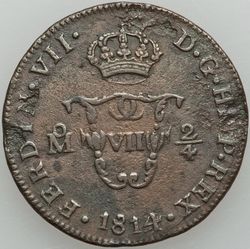
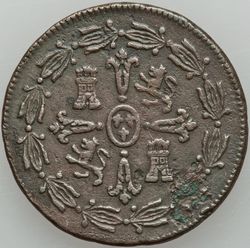
KM-64 ¼ real (2/4 vellón) 1814 Mo
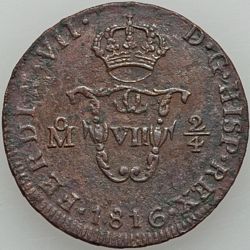

KM-64 ¼ real (2/4 vellón) 1816 Mo
| 1814 | |
| 1815 | |
| 1816 | |
| 1818 | |
| 1821 |
On the obverse, these coins have two intertwined letters F with "VII" in the centre under a royal crown, all between Mo and the value, the legend "FERDIN·VII·D·G·HISP·REX" (Ferdinand VII by the grace of God King of Spain),with the date below. On the reverse, a floral cross with the Bourbon coat of arms in the centre and cantoned with castles and lions is shown inside a laurel wreath. This design was the was a hybrid of two existing coins, on one side a proclamation medal of 1808 in allusion to Ferdinand VIIThe obverse has the shield of Spain surrounded by a fleece collar, with the legend FERDINAND VII DG HISPAN ET IND REX. and the reverse the initials of Fernando VII, with a laurel below and a star above and the legend ACCLAMATIO AVGVSTA MATR D 24 AVG AN 1808 and on the other hand a maravedis coin of the Segovia mint.
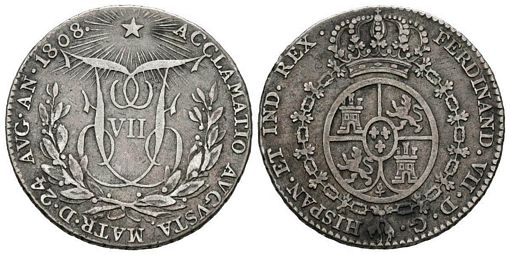
Proclamation medal of Ferdinand VII, 1808
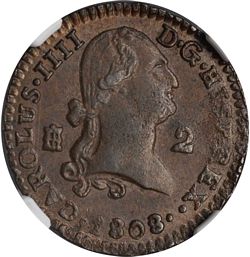

KM 426 2 maravedis, Charles IV, Segovia, 1808 (Stack’s Bowers Auction, 23 October 2019, lot 72776)
The ornate design of the reverse was originally created in 1770 by the engraver Tomás Francisco Prieto.
These coins, despite their original purpose, never managed to eradicate the name tlaco or pilón, nor to eliminate tlacos from circulation; it is estimated that these coins circulated until 1840, when they were amortized by President Antonio López de Santa Anna.
Ben Nibert Ben Nibert, “Understanding the Nomenclature of the Colonial Copper Coinage 1814-1821” in USMexNA journal Vol. IX, No. IV, December 2004 writes that this series presents problems to modem numismatists due to the forgotten intricacies of the archaic Spanish pecuniary policy. Early numismatists incorrectly assumed that the values represented on the coins were in standard reales, while the later use of the terms “tlaco” and “pilon”, while not technically incorrect, do not accurately illustrate their legal values. The series should be known for the denominations as intended by the government, not colloquial terms.
The term tlaco comes from the Nahuatl language word tlachco, meaning half or least quantity. The tlaco became the value of half a quartilla or one eighth real, while the term pilon came to mean half a tlaco or one sixteenth real. In later times, tlaco became a generic term for small value coins: The use of this term survived well into the time of centavos.
Tlacos were tokens (or coins) of necessity created as far back as the mid sixteenth century due to a lack of change under the value of the smallest silver coin; the half real. Originally created by merchants, these tokens could be given to a customer if small change was required after a coin of larger value was tendered for a purchase. These tokens could only be "spent" at the store of issue; they had little or no value elsewhere and of course, no official backing. Soon many types of merchants were issuing tokens, as were farms, haciendas, mines and businesses that paid them to their workers with. the expectation that they would be spent at the company store. Municipalities soon issued tokens, which became locally accepted small change: this practice to be later imitated by some state governments.
As for the basics of the Spanish and colonial monetary system, two distinct types of gold and silver money existed in Spain and its colonies. Jn peninsular Spain, provincial coinage was used which was lighter and baser than national coinage, which circulated in both Spain and the Indies. One reason for provincial coinage was to discourage the export of deliberately, less valuable money. A subsidiary coinage, provincial was not intended to circulate in the colonies, National coinage fundamentally had full silver and gold value and was relatively stable and universally accepted.
To complicate matters, a third monetary system also existed, which was called vellón. It provided small change. in copper in addition to serving as money of account. By the second half of the eighteenth century, business was transacted and records were kept in terms of vellón as were all mint records. The official monetary relationships in the second half of the eighteenth century were that the national silver real was fixed at 85 vellón maravedis while the provincial real was 68 vellón maravedis. The vellón one real was equal to 34 maravedis. Gold had a more flexible relationship.
As for Mexican history, vellón had not circulated in Mexico, except briefly for the failed maravedis issue of 1542. Small change under one half real was frequently made with cocoa beans which were commonly used until at least the middle of the eighteenth century. In a memorial presented to the Crown in December 1766, Augustin de Corona y Paredes described the tlaco tokens, which were being issued by the merchants of Mexico City, which in his opinion caused hardship for the poor. Jn October 1767, Charles III ordered a stop to the use of tlacos and instructed the Viceroy to consult the merchant guild at Mexico City on the desirability of coining vellón in New Spain. This, the guild rejected; it was against their economic interest to eliminate tokens. So, in December 1769, the Crown decided against vellón coinage. The prohibition of the use of tlacos was not enforced nor was a substitute found for the small change problem. Finally in August of 1789, Viceroy Revillagigedo denounced the token system and urged the Crown to coin copper vellón for use as soon as possible. Still, the Crown refused to introduce vellón but did introduce a silver quartilla, which was a new denomination, authorized by royal decree. These quartillas proved to be of inconvenient size as well as being struck in inadequate quantities. In 1814 Viceroy Calleja again ordered the removal of the token tlaco and pilones from circulation to be replaced with official coins.
The new coinage has its beginning with the decree of 28 March 1814 in which the Spanish, Superior Council of Finance mandated that vellón copper be minted in Mexico. On 4 June 1814 Viceroy Calleja ordered the circulation and use of vellón copper. On 23 August 1814 Calleja announced that vellón copper coins of one half, one and two quartos (2, 4 &. 8 maravedis) had already been minted and were ready for circulation. These were some of the same denominations circulating in Spain. In the vellón system we find the derivatives:
2 maravedis equals one ochavo or ⅛, the denomination on the smallest coin,
4 maravedis equals two ochavos, equals one quarto or ¼, the denomination on the middle size coin,
8 maravedis equals four ochavos, equals two quartos or 2/4, the denomination on the largest coin.
Equivalents of their values were. spelled out as follows: ⅛ equivalent to a pilon or sixteenth real; ¼ equivalent to a tlaco or eighth real; or 2/4 equivalent to a quarto or quarter real, However, the Viceroy’s decree specified that the new coins be called by their values; the use of colloquial terms was forbidden. The new coins were to replace tokens and remove them from circulation, not to perpetuate their use.
The relationship of this coinage was to be in terms of national currency in which the new copper was to be an extension of the lowest value silver coin, namely the half real. vellón was valued in relation to national coinage which in practice at this time was one real de plata equals two reales de vellón. It is interesting to note the placement of values on both the Spanish and Mexican vellón coins are essentially the same but the Mexican product utilizes maravedis derivatives. Neither have any indication of the value system (maravedi, real, etc).
In conclusion:
1. The denominations of the coins are in vellón, i.e., maravedis or their derivatives. These values must be converted to national in order to find the actual value.
2. In discussing their denominations, the values on the coins should be used with the term vellón, indicating they represent a different accounting system, i.e. 2/4 vellón or 2 quartos vellón; ¼ vellón or l quarto vellón; ½ vellón or 1 octavo vellón. The use of colloquial terms as values was not intended and is confusing to the numismatist.
3. The colonial and Spanish vellón value systems were the same and should be spoken of in the same way,
4. The equivalents, tlaco, pilon, etc, are useful from a historic point of view but ¼, ⅛, and 1/16 are more accurate in describing actual value in relation to the existing silver coinage.
